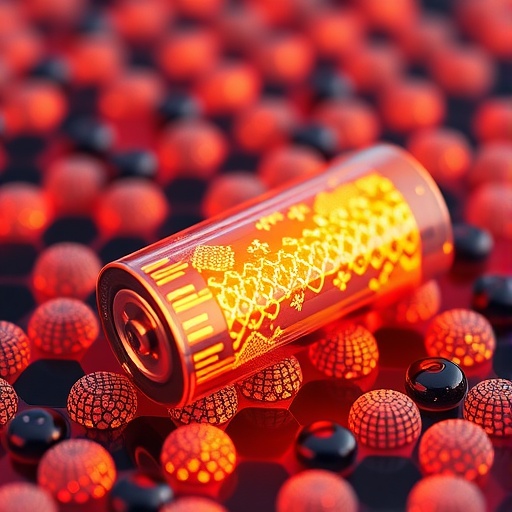In the global quest to achieve the United Nations’ Sustainable Development Goals (SDGs), the urgency for revolutionary advancements in clean and efficient energy technologies has never been greater. At the heart of this mission lies the development of next-generation energy storage systems capable of supporting vast applications—from powering electric vehicles to stabilizing renewable energy grids. Among these, lithium-oxygen (Li-O2) batteries represent a beacon of promise due to their extraordinarily high theoretical energy density, surpassing that of the well-established lithium-ion batteries. However, unlocking their practical potential has been hindered by significant challenges, primarily related to poor cycle life and rapid degradation mechanisms that undermine performance and durability.
Overcoming the complex degradation pathways in Li-O2 batteries requires a deep understanding of the underlying causes of failure within these electrochemical systems. The fundamental obstacle rests in distinguishing the relative contributions of carbon cathode degradation versus electrolyte decomposition—two intertwined factors that precipitate the decline of battery efficiency. A pioneering research effort led by a multidisciplinary team from Tohoku University, including Professor Hirotomo Nishihara and Dr. Wei Yu, has made a landmark breakthrough by synthesizing a novel high-purity (> 99%) ^13C-labeled graphene mesosponge (13C-GMS). This innovative material acts as an exceptional investigative platform to elucidate the distinct degradation phenomena within Li-O2 batteries.
Graphene mesosponge, a hollow, sponge-like carbonaceous framework characterized by high flexibility and an extensive surface area, serves as a uniquely advantageous scaffold for electrochemical applications. Its tailored architecture, combined with isotopic labeling using the ^13C isotope, provides an unprecedented means to trace carbon-specific degradation precisely. By integrating polymorphic ruthenium (Ru) catalysts within this mesosponge framework, the research team successfully constructed a well-defined system with controlled catalytic properties. This design enabled highly selective evaluations on how different Ru crystal phases influence battery failure mechanisms, thereby decoupling the adverse effects attributed to the cathode and the electrolyte.
The researchers employed an array of sophisticated characterization techniques, including quantitative spectroscopy and advanced theoretical simulations, to dissect the interactions at the cathode-electrolyte interface. Through these integrated methodologies, they revealed that the suppression of carbon cathode degradation is effectively achieved by lowering the charge potential during battery operation. Nevertheless, the choice of Ru catalyst polymorphs manifested a marked impact on the rate and extent of electrolyte decomposition, illustrating how catalyst morphology critically governs parasitic side reactions detrimental to the battery’s lifespan.
This fine-grained insight into the ‘weakest link’ within Li-O2 batteries—whether it be structural decay of the carbon scaffold or electrolyte breakdown—ushers in a paradigm shift in battery design and optimization. It equips researchers and engineers with actionable knowledge to strategically target specific degradation pathways to enhance overall battery resilience and efficiency. As Dr. Wei Yu emphasizes, the ability to pinpoint which component requires improvement paves the way for engineering more robust and practical Li-O2 batteries, poised to fulfill the demands of future sustainable energy infrastructures.
Beyond resolving longstanding debates over the role of solid-state catalysts in Li-O2 battery durability, this research signifies a critical advancement toward sustainable energy storage solutions that align with global environmental commitments. By unveiling the interplay between carbon materials and catalytic polymorphs, the study advises on new material selection criteria and optimized operating conditions to prolong battery longevity and operational stability. These revelations form a foundational step toward accelerating clean energy technology innovation and supporting carbon neutrality objectives worldwide.
The implications of this work extend deeply into materials science and electrochemistry, highlighting the synergy between isotopic labeling techniques and catalyst engineering as potent tools to tackle complex battery degradation challenges. The approach demonstrated by Nishihara, Yu, and colleagues underscores the necessity of combining experimental rigor with theoretical modeling to decode multifaceted electrochemical phenomena—an approach that will likely inspire analogous investigations across various energy storage platforms.
Published in “Applied Catalysis B: Environment and Energy” on September 29, 2025, the study represents a landmark in the field. It also showcases the power of international collaboration, with significant contributions from researchers affiliated with Gunma University, Kyushu Synchrotron Light Research Center, Manchester Metropolitan University, and the University of Cambridge. Together, these efforts exemplify the promising future of cross-border scientific endeavors in addressing global energy and sustainability challenges.
As the global transition towards electrification and renewable energy intensifies, breakthroughs such as this provide a scientific compass guiding the design of next-generation battery technologies. High-energy-density Li-O2 batteries, empowered by advanced carbon electrodes like the ^13C-labeled graphene mesosponge integrated with customized Ru catalysts, are poised to revolutionize energy storage paradigms. This research not only illuminates the path to stable, efficient battery operation but also contributes fundamentally to the broader pursuit of an environmentally sustainable and technologically innovative energy future.
Looking ahead, the insights gleaned from this study open myriad avenues for future exploration, including fine-tuning catalyst polymorph structures, developing novel electrolyte formulations resistant to decomposition, and expanding isotopic labeling strategies to other battery components. Such continued research endeavors are critical to overcoming the remaining hurdles on the journey to commercially viable Li-O2 energy storage solutions.
In sum, this pioneering research advances the frontier of lithium-oxygen battery science by elegantly decoupling complex degradation pathways with high-precision materials and catalyst engineering. It offers the electrochemical energy community vital new design principles that harmonize cutting-edge nanomaterials science with sustainable energy imperatives, marking a substantial leap toward realizing the full potential of clean, efficient, and durable energy storage systems essential for the future.
Subject of Research: Lithium-oxygen (Li-O2) batteries, degradation mechanisms, and catalyst engineering using ^13C-labeled graphene mesosponge and polymorphic ruthenium catalysts
Article Title: High-Purity 13C-labeled Mesoporous Carbon Electrodes Decouple Degradation Pathways in Li-O2 Batteries with Polymorphic Ru Catalysts
News Publication Date: September 29, 2025
Web References: http://dx.doi.org/10.1016/j.apcatb.2025.126030
Image Credits: © Zhaohan Shen et al.
Keywords
Catalysis, Solid state chemistry, Graphene, Batteries
Tags: battery failure analysiscarbon cathode degradation mechanismsclean energy solutions for electric vehiclescycle life improvement in batterieselectrolyte decomposition in Li-O2 batteriesgraphene mesosponges in energy storagelithium-oxygen battery challengesnext-generation energy storage systemsperformance optimization of lithium batteriesresearch breakthroughs in battery technologysustainable energy technology advancementsTohoku University energy research initiatives





